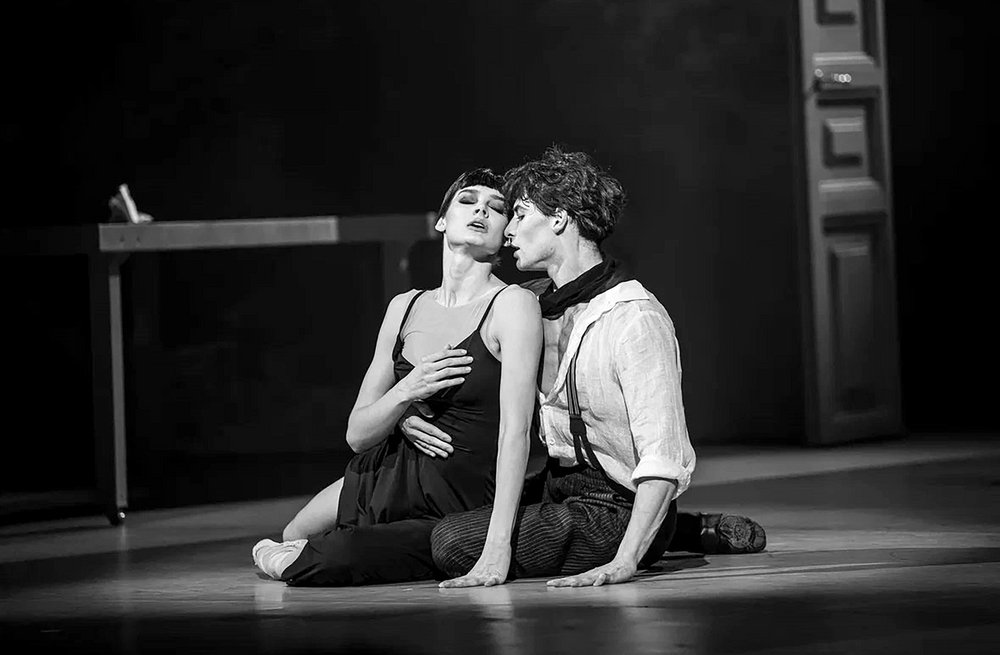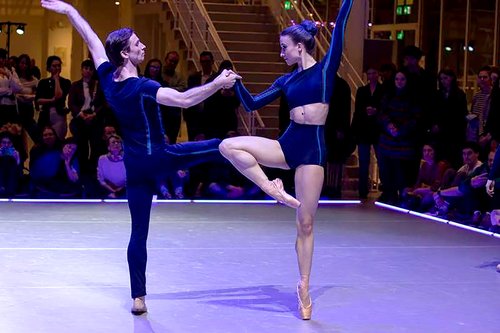Posokhov Crosses Classical Ballet with Poetry Readings

Two Annas. Anna Akhmatova. Staged by Yuri Posokhov. Photo by Yulia Mikheeva. Courtesy of the International Festival of Arts ‘Diaghilev. P.S.’
Choreographer Yuri Posokhov is known for his love of the great Russian ballet traditions as well as Russian classical literature yet there is also room for experiment in his productions as shown by his most recent creation dedicated to the poet Anna Akhmatova which has just premiered in St Petersburg as part of the International Festival of Arts ‘Diaghilev. P.S.’.
The ballet ‘Two Annas’, produced by MuzArt company, is actually two separate works set to music written by two different composers, staged by different choreographers and dedicated to two heroines: Anna Akhmatova and Anna Pavlova. Pavlova’s biopic was created by a young choreographer Pavel Glukhov (b. 1986) and Akhmatova’s was choreographed by Yuri Posokhov (b. 1964), who is one the most famous creators of neoclassical ballets in the world today. A staff choreographer at the San Francisco Ballet, Posokhov has worked for the Copenhagen Opera, the English National Ballet, the Joffrey Ballet in Australia, the Mariinsky Theatre in St Petersburg, and in Moscow at the Bolshoi, where in his youth he danced for a decade, before moving abroad in 1992. When asked whether he adapts Russian classics for international audiences, he says “I am Russian at heart, although I feel like a man of the world”.
In Moscow and St Petersburg, Yuri Posokhov is best known today as a creator of narrative ballets and plastic interpretations based on Russian literature, yet in the technique of classical ballet he creates works of contemporary art. Topical, sometimes acutely social, piercingly sensual, with a subtle understanding of human nature, his ballets feel bothauthentic and organic in the 21st century. Without changing the classics, Posokhov somehow manages to create an interpretation and reading that feels inherently relevant to us today. “If you want to live consciously, with both a vision and an understanding of beauty, there is only one way to do it: read the classics,” says the choreographer.
Posokhov talks about his characters as if they are members of his family, people he knows perhaps even too well so thathe does not have any illusions about them loving them because they are his own; and there is no escape from them. “Princess Mary is almost a child. Well maybe a college student... But how she has grown up! Her childish sufferings have turned her into a grown-up woman,” he says of the heroine of his 2015 ballet ‘A Hero of Our Time’ which was directed by Kirill Serebrennikov (b. 1969), based on Mikhail Lermontov's novel of the same name and staged at the Bolshoi Theatre. He is talking about the romantic trio in the final scene of the ballet, the most powerful scene where the protagonist, Pechorin dances with two women, Vera who is married – he climbs into her bedroom through the window at night – and Princess Mary, with whom he flirts in public at the thermal spring. He is attracted to both of them, cannot refuse their love interest and both of them suffer in the end. While Lermontov's novel contains only a hint at Vera and Pechorin's relationship, in Posokhov's production she is a heroine equal in importance to Princess Mary. The choreographer shows his Pechorin through both a secret love affair and a public society courtship. This nuance meant some off the cuff rearranging of the script as Posokhov reveals how the ballet was initially just too long and a piece of music to which apas-de-trois of the three protagonists Vera, Pechorin and Princess Mary had been set was cut out. But then Posokhovrealised that this was actually the ballet’s emotional peak so he called the composer Ilya Demutsky: “Bring back this piece, I can’t live without it! We won’t tell Kirill, we’ll insert a little fragment, and he won't notice!” .
Both choreographer and librettist Valery Pecheikin (b. 1984) took pity on Lisa from ‘The Queen of Spades’, which is being performed at the Bolshoi. Unlike libretto of the opera, in the ballet version Lisa does not drown herself. “We are kind!” – says Yuri Posokhov. Instead, their victim is Hermann, a gambler and the protagonist of the play. Having frittered away all his fortune and been rejected by Lisa as there are more than enough successful young officers in her sights, Hermann literally implodes, dancing to death (a nod to Diaghilev and his ‘Sacred Spring’) with the old Countess who comes to him from the underworld. At the same time, the balls in St Petersburg and Versailles resemble macabre dances in the style of ‘The Joker’, and the palace interiors created by set designer Polina Bakhtina as an ironic portrait of contemporary Russian neo-bourgeois gloss, evoke the interiors of Boris Zarkov’s fashionable restaurants in Moscow loved by wealthy Russians.
“Everything can be portrayed in art,” says Posokhov, “The other question is how. If you stop things from being expressed or being shown on the stage then we are all diminished. You need to reflect all the different aspects of life through art”.
He compares his work as a choreographer to the art of a sculptor. “The actors at the Bolshoi Theatre are versatile and you can sculpt them like clay. This is how I create my characters”. In Posokhov’s understanding, contemporary ballet is closer to architecture and sculpture than to drama theatre. “I manipulate the artists like a sculptor manipulates his or her material. And it is not so important what the dancers have read about their hero and how it resonated with them. What I need above all is that they accurately convey what I have in mind”.
Posokhov took on the ‘Two Annas’ project with characteristic spontaneity, accepting the story of Anna Akhmatova (1889–1966) without a second’s hesitation. Akhmatova, however, unlike Princess Mary, or Konstantin Treplev from Chekhov’s ‘The Seagull’ or the Queen of Spades, was less fortunate. In his ballet Posokhov created different Annas, a prima ballerina of the Bolshoi Theatre and grand-niece of Matilda Kshesinskaya (1872–1971), ballet star and mistress of the last Russian Emperor Nicholas II danced by Eleonora Sevenard (b. 1998); and a role played by actress Polina Malikova-Tolstun, (b. 1985) in which Anna recites poems by Akhmatova. The Anna en pointe dances, and the other Anna in heels. Akhmatova’s affair with artist Amedeo Modigliani (1884–1920) – the only evidence of which are a couple of sketches of her by Modigliani, preserved by the poetess – is staged against the backdrop of her wedding trip to Paris with her husband, the poet Nikolai Gumilev (1886–1921). Gumilev is buttoned up in suit and tie and looks straight ahead, composed yet stiff. Daniil Potaptsev (b. 2004), a young Bolshoi dancer, portrays his character as the ideal partner of an unfaithful wife, who is either blind and unfeeling, or stupefied by what is happening. Both of these undermine the popular image of Nikolai Gumilev as a brave officer, poet, scientist, lover of exoticism and adventure, and traveller across the African continent.
In ‘Two Annas’, Gumilev-Potaptsev seems to move around the stage with the sole purpose of physically supporting his wife Akhmatova after the most challenging leaps and pas. As Modigliani, Alexei Putintsev is better placed to prove himself on stage. But his passion and his love are never truly revealed. Proof of his powerful temperament might have come in a scene in his studio with his model and mistress danced by Yaroslavna Kuprina, (b. 2004), but here the most interesting thing turns out to be her lace underwear peeping out from under a thin layer of tulle. And Akhmatova suddenly appears as an ominously wise old woman, leafing through old photo albums looking at the faded images of her young lovers with astigmatic eyes. Posokhov once portrayed Pushkin's heroine in the Queen of Spades as an infernal beauty, equal in power and strength to the young officer, who had come from the netherworld to finish playing her part. “Does your Akhmatova resemble the Queen of Spades,” I could not resist asking. “Get real, you're making things up,” was the choreographer's reply, “reread the classics!”.





















